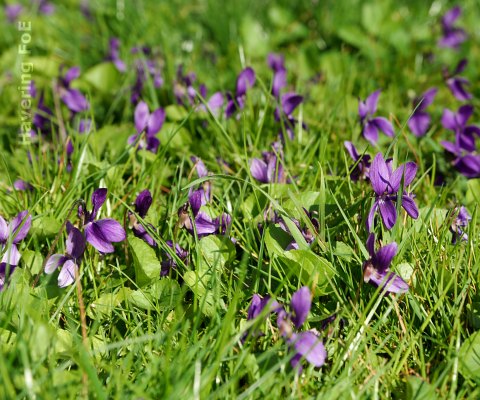Grass: Real vs Fake
by Peter Caton; first published 19-Sep-2025

Violets growing in a real grass lawn - John Robinson
One in ten gardens now contain artificial grass. It doesn't require cutting, watering, fertilisers or herbicides and stays green even in droughts. For those who prefer a sterile, low-maintenance, plastic covering on their garden, it seems a good idea. Fake grass may be green in colour however it is far from green when the environment is considered.
Artificial grass is plastic. Each square metre weighs about 1.4kg. Twenty square metres contains roughly the same amount of plastic as 27,500 drinking straws. It takes a lot of energy to manufacture and transport, and is very difficult to recycle.
A real grass lawn is a living entity. Above ground, insects take nectar from daisies, buttercups, dandelions and a host of wildflowers if mowing is delayed in early summer. Birds feed on seeds, insects and invertebrates who live in the earth below. A layer of plastic means no life in the soil and an area dead to nature.
A natural lawn acts as an air filter, absorbing dust and pollutants that would otherwise be breathed in by us. It allows water to drain into the earth and whilst fake grass does permit some draining, it can't cope with downpours, run-off potentially leading to flooding.
Grass absorbs sound, reducing noise pollution, whereas it just bounces off plastic. It doesn't get hot, unlike artificial lawns which absorb heat and can become too hot for people and pets to walk on. Like all living plants, grass takes up carbon dioxide and releases oxygen.
A natural lawn doesn't have to take much effort to look after. Watering isn't necessary even in a drought – it will return to green as soon as rain falls. Herbicides aren't necessary – the odd "weed" will attract bees. They don't need cutting frequently – and if at least part of the lawn is left until June grasses and wildflowers add aesthetic and wildlife interest. If using a traditional lawn mower becomes difficult one could purchase a robot mower for a fraction of the cost of installing fake grass. A plastic lawn still has to be swept or vacuumed. Grass cuttings and leaves decompose to fertilise a natural lawn, or can be composted, putting goodness back into the garden for no cost at all.
It is of course a matter of individual preference as to which looks best but there can be no doubt that a natural lawn is cheaper and far better for our environment.
![[Earth icon]](../emblem64.jpg)